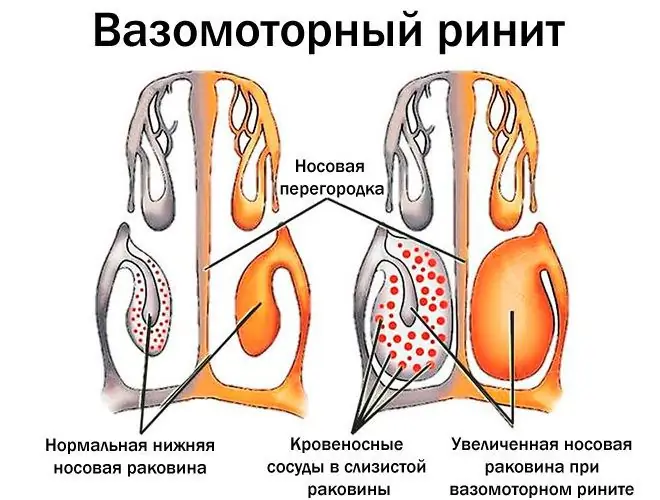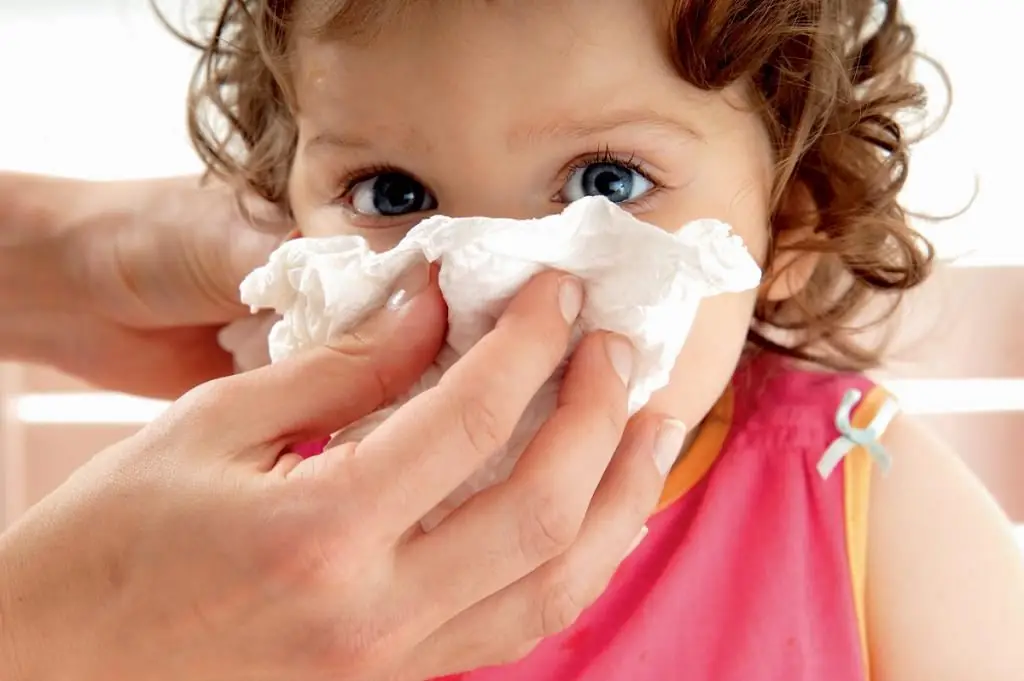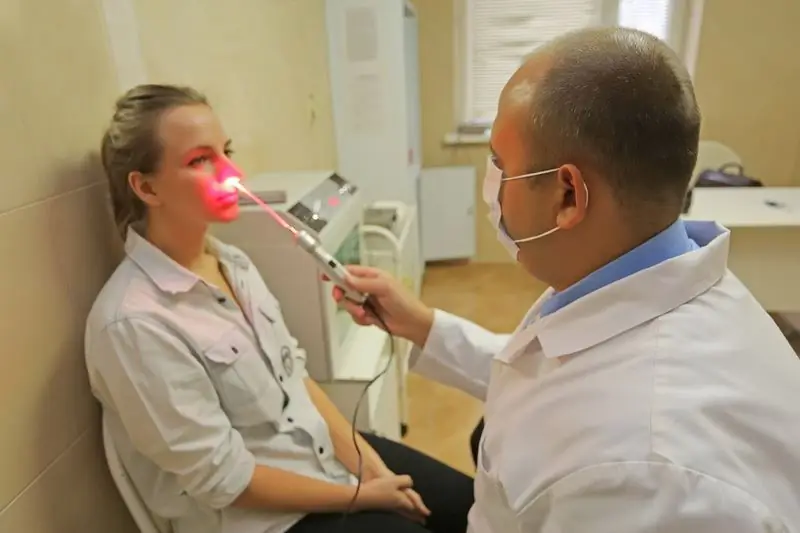- Author Curtis Blomfield [email protected].
- Public 2023-12-16 20:44.
- Last modified 2025-06-01 06:18.
Unfavorable external and internal factors affect the vessels of the nasal wall, which over time acquire a tendency to expand to reflex stimuli (pungent odor, cold air). As a result, a disease called vasomotor rhinitis develops. They affect about ten percent of the population. A quarter of these patients have a persistent symptom of the disease. The disease affects people of all ages, with women being affected twice as often as men.
Causes of disease development
The main cause of the disease is a disruption of the autonomic nervous system, as a result, the vessels of the mucosa cease to respond correctly to external environmental conditions. There is a constant nasal congestion, which is considered the main symptom of vasomotor rhinitis. This disease can be caused by both external and internal factors. The former include the following:
- a sharp change in the temperature of the inhaled air;
- quick change of atmospheric pressure;
- smoke pollution,strong odors;
- ARVI.

Internal factors:
- emotional and stressful situations;
- loads: physical and sexual;
- hormonal disorders (puberty, pregnancy, menstruation, taking growth hormones);
- spicy food, alcohol, nicotine;
- defects in the nasal cavity (deviated septum, adenoids);
- prolonged use of vasoconstrictor drops;
- long-term use of drugs that affect the autonomic nervous system (neuroleptics, anticonvulsants, antihypertensives);
- hereditary predisposition.
Classification
There are several types of vasomotor rhinitis with different causes and development mechanisms:
- medicinal - develops against the background of taking drugs;
- hormonal - formed as a result of changes in hormonal balance;
- reflex - vascular reaction to cold, food, alcohol, bright sunlight, strong odors;
- psychogenic - formed against the background of emotional overload;
- idiopathic - cause unknown;
- mixed.
Signs of rhinitis
This common disease is a serious pathology, which is expressed by changes in the functions of the nasal cavity. Each patient has a disease that manifests itself in its own way: with a large number or minor signs and is difficult to treat.
Main symptoms of vasomotor rhinitis:
- Alternate constant or periodicnasal congestion. Most often this manifests itself in the prone position and when turning from side to side.
- General weakness, malaise.
- Mucococcal discharge from the nose can be heavy, moderate or slight. They do not leave marks on the handkerchief after drying, do not become thick and yellow, there is no purulent snot.
- Burning and itching sensation in the nasal area.
- Sneeze intermittent or constant. It can suddenly appear and also stop.
- Headaches, decreased sense of smell.
- With allergic rhinitis, hyperthermia, redness of the eyes, tearing are possible.
- Snot running down the back of the throat.
With any type, including vasomotor rhinitis, the following are possible: loss of appetite, migraine, insomnia, loss of attention, shortness of breath.
Diagnosis
Rhinitis is diagnosed by exclusion. The main symptom by which this disease is determined is dependence on vasoconstrictors (decongestants). An important diagnostic task is to find out the nature of deviations from the norm, that is, to understand whether rhinitis is allergic or not. For this, special allergy tests and clinical blood tests are carried out. In addition, diagnostics suggests:
- Anamnesis collection - clarification of the patient's complaints, information about the nature and amount of mucus from the nose, the duration of the disease, seasonality and other signs.
- General examination allows you to find out if there are signs of vegetovascular dystonia: low body temperature, pressure, cold extremities, nervous tension, weakness.
- Rhinoscopy. They study the condition of the nasal mucosa and its sinuses, the presence or absence of curvature of the nasal septum.
- Bacteriological examination of the nasal mucosa. It is carried out in order to exclude infectious rhinitis.

When the diagnosis of vasomotor rhinitis is confirmed, the treatment prescribed by the doctor will be comprehensive.
Preparing for therapy
This seemingly harmless disease requires systematic and long-term treatment. First of all, you need to follow the following advice from experts:
- Cancel all circumstances that provoke the development of the disease. The patient should give up alcohol, smoking, avoid strong odors, avoid strong temperature changes, and exclude certain foods that are allergens.
- Treat chronic gastrointestinal diseases.
- Remove nasal anomalies, if any, that are causing rhinitis.
- Start physical education: morning exercises, swimming in the pool, running, walking. All this will help to normalize the autonomic nervous system.
- Take contrast showers daily. This is an excellent procedure for hardening the body, helping to relieve some of the symptoms.
All of the above activities will help alleviate the patient's condition.
Sanitation of the nasal cavity
This manipulation is carried out to eliminate the causes that provoke an exacerbation of rhinitis. Saline solutions are usually used for the procedure. With mild flownasal lavage helps to relieve symptoms of vasomotor rhinitis in adults, such as swelling of the mucous membrane.

In addition, the saline solution helps to thin the mucus and remove it from the nasal cavity. A large number of mineral solutions are sold in the pharmacy chain. However, for this purpose, an ordinary saline solution is also perfect, which gives a good effect and is inexpensive. You can also use a solution with ordinary table s alt, after dissolving it in boiled water. Washing the nose is recommended to be done several times a day, especially after contact with allergens. For the procedure, use a pipette, syringe, teapot and other special devices.
Vasomotor rhinitis: symptoms and treatment in adults
In any case, the treatment of this insidious disease cannot do without drugs. As a result of long-term experiments and observations, Russian and foreign experts have identified a number of effective drugs for the treatment of this disease. The following medications may be prescribed to the patient, depending on the symptoms of the disease:
- Systemic vasoconstrictors. The most popular are: Teraflu, Coldrex, Rinza. They relieve swelling of the nasal mucosa.
- Antihistamines. Show anti-allergic effect, relieve swelling and inflammation. These include Suprastin, Cetrin, Loratadin.
- Local glucocorticoids. Used in the treatment of neurovegetative and allergic formsrunny nose. They relieve swelling and inflammation, have a cumulative effect, are not absorbed into the blood and have minor side effects. The most prescribed drugs are Avamys and Nasonex.
- Local vasoconstrictors. Drops "Farmazolin", "Nazol", "Otrivin" facilitate breathing, relieve congestion and swelling. They are used for a short time, as they are addictive and subsequently have the opposite effect.
- Combined. The composition includes anti-allergic and vasoconstrictor components. "Sanorin analergin", "Vibrocil" are used for no more than five days.
- Improve blood circulation. These include Aescusan and Glivenol.
- Homeopathic. These funds are characterized by a mild cumulative effect. Most often appoint "Sinupret" and "Delufen". They have a complex therapeutic effect.

Together with the above drugs for the treatment of vasomotor rhinitis in adults, vitamins of groups B, A, E and C are prescribed to strengthen the nervous system and vascular walls. All medicines are selected by the doctor, taking into account age, comorbidities and various individual characteristics of the patient.
Physiotherapy treatments
Used as an additional method of treatment in combination with other means. The following procedures have proven to be highly effective:
- UHF (Ultra High Frequency Therapy) - helps to reduce swelling, facilitates nasal breathing. The course is from 5 to 7 sessions, which are held daily.
- UVI (ultraviolet radiation) -prescribed for acute symptoms of vasomotor rhinitis, treatment in this case consists of a short course: one or two sessions, the duration of which is 0.5-2 minutes.
- Laser therapy - the nasal mucosa is exposed to infrared rays.
- Photodynamic therapy - the nasal mucosa is irrigated with minerals.
Physiotherapeutic procedures improve the patient's condition and reduce the severity of the symptoms of the disease.
Surgical treatment
At the diagnosis of "vasomotor rhinitis", the operation is done in the case when the drug treatment was ineffective. Any surgical intervention will only facilitate nasal breathing. It has almost no effect on nasal discharge, sneezing, itching and smell. Surgical treatment contributes to the correction of anatomical defects in the nasal cavity and vasoconstriction. Basic surgical treatment methods:
- septoplasty - correction of the nasal septum, removal of various formations in the nasal cavity, as well as separation of the mucous membrane from the periosteum;
- ultrasonic disintegration - atrophied overgrown vessels are removed that create nasal congestion;
- laser destruction - laser cleaning of the conchas of the nose and vasoconstriction;
- electroplasma coagulation - destruction of damaged vessels;
After such treatment of vasomotor rhinitis in adults, swelling of the nasal mucosa stops, the work of the ciliated epithelium and glands is restored.
Rhinitis in children
The disease in babies is mainlyIt is formed against the background of the growth of adenoids as a result of injuries, congenital defects of the nasal septum, the development of polyps and inflammatory processes of the maxillary sinuses. When the underlying pathology is cured, the symptoms of rhinitis quite often disappear.

The disease can be both seasonal and permanent. Usually, vasomotor rhinitis is detected in a child at an early age. Problems with nasal breathing impair blood circulation. The child often complains of headaches, fatigue. He cannot concentrate and be attentive. Doctors recommend starting treatment immediately. It provides for anti-inflammatory therapy, taking antihistamines and vasoconstrictor drugs. In complicated cases, surgical intervention is used.
Vasomotor allergic rhinitis
It is a type of neurovegetative inflammation of the nasal mucosa, which is provoked by allergies. Allergic vasomotor rhinitis can be up to nine months annually with daily exacerbations or only appear seasonally. This disease is caused by the following factors:
- allergens from the environment - mites, dust, animal hair and saliva, mold, chemicals, food;
- allergens from the internal environment - toxins that are released by the body in violation of metabolic processes;
- allergens from medicines - vaccines, serums, tablets, potions, powders;
- physical factors of an aggressive nature - hypothermia, mechanical irritation, thermalaction, high humidity, drafts.

Rhinitis, allergic or not, is chronic vasomotor rhinitis. Seasonal attacks of the disease are most often observed during the flowering period of plants. Attacks appear several times a day and last from one to three hours. The nasal passages at this time are inflamed, there is severe swelling, the mucous membrane is blue, the turbinates are enlarged. Year-round allergic vasomotor rhinitis has the same symptoms. During the remission period, these signs are not observed. How to treat vasomotor rhinitis has been described before.
Therapy of rhinitis in pregnant women
During pregnancy, the female body is restructured. As a result, immunity decreases, hormonal changes occur, and as a result, some diseases occur, including vasomotor rhinitis. This disease, as a rule, begins in the first weeks and disappears by seven months of pregnancy. In some cases, the disease manifests itself in the second half of pregnancy and ends after delivery. To alleviate the condition and treat vasomotor rhinitis in pregnant women, prescribe:
- Vasoconstrictor Drops - Use only for short courses and as directed by a physician.
- Washing the sinuses with saline solutions. This procedure relieves swelling well and is safe for the he alth of a woman and a child.
- Using natural based oil drops.
- Inhalations with alkaline mineral water. It is recommended to use a specialnebulizer device.
The main cause of symptoms of vasomotor rhinitis in pregnant women is a hormonal imbalance in the body. Treatment should be gentle and not harm the expectant mother and fetus.
Complications of the disease
In the absence of timely treatment, the following consequences may occur:
- infectious diseases of the lungs and upper respiratory tract, when breathing through the mouth, cold air is not warmed and not cleaned;
- bacterial rhinitis and sinusitis, an infection gets on the inflamed nasal mucosa;
- hearing loss due to inflammation in the auditory tube, which is associated with the nasopharynx;
- polyps are formed due to the growth of the mucous membrane and require surgical intervention;
- growth of connective tissue in the mucous membrane and polyps. Surgical treatment is mandatory.
With a timely visit to a doctor who will prescribe individually selected and effective medicines, all these troubles can be avoided.
Rhinitis lifestyle and nutrition
To strengthen blood vessels, you need a he althy lifestyle and proper nutrition. For this you need:
- hardening - stimulates and strengthens blood vessels; start in the warm season, gradually lowering the temperature of the water for bathing and dousing;
- physical activity - train blood vessels, prevent the appearance of hypertension, obesity, improve the functioning of the heart muscle; jogging, walking, cycling, swimming, dancing are recommended;
- full sleep - sleep at leasteight hours a day for an adult;
- daily walks in the fresh air - strengthen the walls of blood vessels, supply the cells of the body with oxygen;
- giving up bad habits, alcohol and smoking - has a beneficial effect not only on blood vessels, but also on the functioning of the lungs, heart, liver;
- proper nutrition - should contain a sufficient amount of vitamins and trace elements, eat more plant products;
- maintaining body weight - sudden changes in body weight adversely affect the functioning of all internal organs;
- food temperature - do not eat too hot or, conversely, cold food;
- annual medical examination - essential for the detection and timely treatment of various diseases of the respiratory system and other organs.
Prevention
This is always the best and easiest way to prevent any disease. You can prevent the development of the disease if:
- be attentive to your he alth: to be treated on time and correctly for any colds;
- avoid inhaling toxic substances with a strong odor;
- use vasoconstrictor drops rarely and no more than five days;
- limit spicy foods, very hot and cold foods, avoid allergens;
- treat the digestive tract in a timely manner;
- perform feasible physical activity: exercise, swim, take walks in the fresh air, use a contrast shower, go to the bathhouse and sauna;
- monitor the humidity inapartment;
- do nose wash daily.
Modern medicine has a lot of effective methods of treating rhinitis, so you should consult a doctor in time and cure the disease completely.
Patient opinions
Many people who suffer from persistent nasal congestion share their experiences on how to treat vasomotor rhinitis.
Patient reviews are as follows:
- Laser treatment. The procedure takes a short time and is painless. The beam acts only on damaged tissues, healing is fast. There are no side effects. Feeling better immediately, breathing is restored.
- Vasotomy. The operation is relatively painless, with little bleeding. Breathing improves immediately.
- Rinse the nose with saline. Pregnant women use this remedy most often. Reviews are different - some are satisfied, others are not. In addition to rinsing, oil-based drops are used, but they do not give the desired effect.

Many people think that vasomotor rhinitis does not require treatment and the symptoms will go away on their own. They believe that this is not a disease, but the body's response to the surrounding ecology. In fact, this is a pathology associated with a violation of the vital activity of blood vessels. It is accompanied by a chronic runny nose, which affects the quality of human life: sleep is disturbed, nervousness and irritability increase, and depression develops. The disease itself is not dangerous, but requires mandatory treatment.






